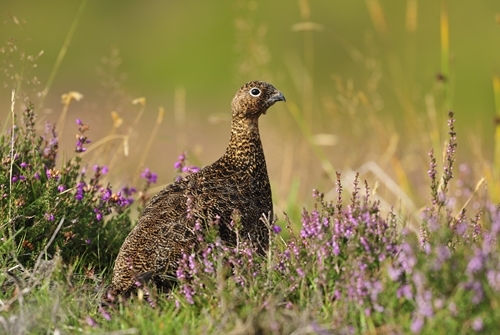Written by Dave Baines, Director of Upland Research
4 Minute Read

Photo credit: Laurie Campbell
The red grouse has a diet almost exclusively of ling heather. The nematode worm tenuis, the causative agent of the disease Trichostrongylus strongylosis, is widespread in red grouse and high levels of infection can cause significant reductions in breeding success and high mortality. The parasite is most abundant when grouse stocks are high and is largely responsible for the cyclical fluctuations in grouse numbers in northern England.
Our latest research considers red grouse nutrition and disease. Conventionally, we have estimated strongyle worm parasite intensity in autumn by sampling adult worms in shot red grouse. In springs 2020 and 2021, we sampled strongyle worm eggs in grouse (caecal) faeces on 24 moors in Teesdale and Swaledale to gauge whether it was practical to do so, and to determine whether estimates of parasite intensity made in spring 2020 were better predictors of subsequent red grouse breeding success than those from autumn shot adult grouse.
Surprisingly, we found that neither worm eggs in spring, nor adult worms in autumn, were significantly related to grouse breeding success. This was especially unexpected given that worm egg counts varied 25 fold across sites, that subsequent grouse breeding success varied five-fold, and that grouse dying from strongylosis were encountered on at least three sites during spring counts and two sites during July counts.
While measuring parasite intensity in spring 2020, we also recorded very extensive damage to heather across moors in northern England. This followed outbreaks of heather beetle in spring 2019, with the impact of their larvae on heather becoming evident during our grouse counts in July 2019, and showing little recovery in the autumn months. By spring 2020, vast areas of heather were grey, appearing dead or seriously damaged by the previous year’s attack. We made initial assessments of the beetle’s impact on heather in spring 2020 and concluded that poor heather quality negatively influenced grouse distribution and appeared to cause hens to abandon those territories of cocks where the heather was most damaged.
Intrigued, we extended our heather damage assessments that autumn to the 24 grouse count sites where we had also collected parasite data (worm eggs in spring and adult worms in autumn). Here, we estimated the proportion of heather that was grey and appeared dead within 30 to 100 quadrats, each measuring 25m2, from within each area. We hypothesized that poor heather quality following beetle damage would impact upon grouse breeding success. Testing this, we found lower grouse breeding success (ratio of young to adult birds in the July count) where the degree of heather damage was higher, with parasite egg counts in spring only of secondary importance.
In conclusion, among our 24 Tees-Swale grouse count sites in 2020, heath moors on shallow peats lower down the dales were generally more impacted by heather beetle, while high altitude sites on deep peat at the head of the dales were often least affected and here grouse tended to breed well, especially where parasite intensities were lower.
However, things have now moved on. Those higher altitude sites previously largely unaffected by heather beetle have now hosted attacks leading to widespread heather damage. Heather lower down the hill has generally failed to recover from previous attacks and the vast majority is grey (dead?) or brown (stressed or dying?) and maybe only 5% is green (nutritious to grouse?). Worm intensities have risen and some grouse were dying from strongylosis on some moors during our spring 2021 counts. To further compound the complexity of nutritional problems facing grouse this spring, the abundance of cotton grass flowers is down by 76% relative to last spring. The flowers appear in March; they are protein-rich and grouse rely on them, particularly hens when forming their clutches. Just when you thought things couldn’t get worse, the intensely cold nights of late April and early May have frosted much of the remaining heather, turning it orange-red.
A combination of dead, dying and poor-quality heather following beetle attacks, winter browning and recent frosts, together with fewer cotton grass protein-boosts and rising numbers of parasites, despite medicated grit, are likely to make this another difficult grouse year across many moors in northern England.
Living head-high among its ubiquitous food plant, it is difficult to appreciate that grouse this spring may be nutritionally challenged, but that appears to be the case. Clutch sizes appear low and while the first chick was spotted this week (5 May), many hens at higher altitudes, now once again covered by late snow, appear yet to lay eggs. Moving forward, this spring our upland research group has initiated plot-based experiments to consider whether heather burning, cutting or simply leaving it alone is the best way of managing heather recovery following beetle outbreaks.
Meanwhile, our burn-cut experiment, initiated the previous spring, is already suggesting that burning promotes greater cotton grass flowering abundance. Restoring heather and promoting cotton grass flower abundance will be a key management on many English uplands in the years to come. We will provide further results from these experiments in due course.